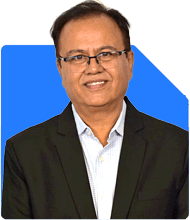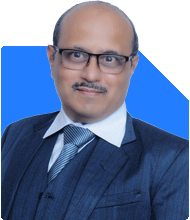Is 10K monthly enough for a decent post-retirement nest egg at age 39?
Ramalingam Kalirajan |10893 Answers |Ask -Follow
Mutual Funds, Financial Planning Expert - Answered on Jan 22, 2025
He has an MBA in finance from the University of Madras and is a certified financial planner.
He is the director and chief financial planner at Holistic Investment, a Chennai-based firm that offers financial planning and wealth management advice.... more

sir my monthly income is approx 50000 expense around 35000 can invest 10000 per month my age is 39 F can invest till 10 years for minimum dont have any specific goals just want to have a decent amount at the time of retirement no loan or liability as of now kindly advise with specific MF /Shares /LIC where to invest
Monthly income is Rs. 50,000, with Rs. 10,000 available for investment.
You aim to build a retirement corpus over 10 years.
Recommended Savings and Investments
Equity Mutual Funds
Allocate 60% of your Rs. 10,000 to equity mutual funds.
Equity mutual funds provide long-term growth and inflation-beating returns.
Invest through SIPs for disciplined and consistent investments.
Actively managed funds offer higher returns than index funds over the long term.
Hybrid Mutual Funds
Allocate 20% of your investment to hybrid mutual funds.
These funds offer a mix of equity and debt for moderate growth.
They reduce the risk of market volatility.
Debt Mutual Funds
Allocate 10% to debt mutual funds for stability and short-term needs.
Debt funds are safer than equity and provide consistent returns.
Use these for medium-term goals or emergencies.
Public Provident Fund (PPF)
Invest 10% of your monthly amount in PPF.
PPF offers tax-free returns and secure long-term growth.
It is an excellent addition to equity and debt investments.
Importance of Regular Reviews
Review your portfolio every year to track performance.
Adjust investments based on market conditions and life changes.
Rebalance to maintain the right mix of equity and debt.
Build an Emergency Fund
Save 3-6 months of expenses in a liquid fund or savings account.
This protects you from financial stress during emergencies.
Health and Life Insurance
Ensure adequate health insurance for yourself.
Get a term life insurance policy if you have dependents.
Avoid Common Pitfalls
Do not invest in real estate for retirement planning.
Avoid index funds and ETFs due to their lack of active management.
Stay away from ULIPs or investment-cum-insurance products.
Tax Planning for Investments
Use tax-saving instruments under Section 80C, like PPF or ELSS.
Track the new tax rules for mutual fund capital gains.
Consult a Certified Financial Planner for personalised tax advice.
Finally
Start a SIP of Rs. 10,000 across equity, hybrid, and debt mutual funds.
Add PPF for tax-free and stable returns.
Review your plan yearly and increase SIPs as income grows.
Focus on disciplined savings and diversification for a secure retirement.
Best Regards,
K. Ramalingam, MBA, CFP,
Chief Financial Planner,
www.holisticinvestment.in
https://www.youtube.com/@HolisticInvestment
You may like to see similar questions and answers below
Sunil Lala | Answer |Ask -Follow
Financial Planner - Answered on Nov 05, 2023
Ramalingam Kalirajan |10893 Answers |Ask -Follow
Mutual Funds, Financial Planning Expert - Answered on Apr 04, 2024
Sanjeev Govila | Answer |Ask -Follow
Financial Planner - Answered on Jan 23, 2024
Ramalingam Kalirajan |10893 Answers |Ask -Follow
Mutual Funds, Financial Planning Expert - Answered on May 07, 2024
Ramalingam Kalirajan |10893 Answers |Ask -Follow
Mutual Funds, Financial Planning Expert - Answered on Jul 17, 2024
Nitin Narkhede |113 Answers |Ask -Follow
MF, PF Expert - Answered on Dec 15, 2025
Nitin Narkhede |113 Answers |Ask -Follow
MF, PF Expert - Answered on Dec 15, 2025
Ramalingam Kalirajan |10893 Answers |Ask -Follow
Mutual Funds, Financial Planning Expert - Answered on Dec 15, 2025
Ramalingam Kalirajan |10893 Answers |Ask -Follow
Mutual Funds, Financial Planning Expert - Answered on Dec 15, 2025
Radheshyam Zanwar |6746 Answers |Ask -Follow
MHT-CET, IIT-JEE, NEET-UG Expert - Answered on Dec 15, 2025
Ramalingam Kalirajan |10893 Answers |Ask -Follow
Mutual Funds, Financial Planning Expert - Answered on Dec 15, 2025
Ramalingam Kalirajan |10893 Answers |Ask -Follow
Mutual Funds, Financial Planning Expert - Answered on Dec 15, 2025
Ramalingam Kalirajan |10893 Answers |Ask -Follow
Mutual Funds, Financial Planning Expert - Answered on Dec 15, 2025
Samraat Jadhav |2508 Answers |Ask -Follow
Stock Market Expert - Answered on Dec 15, 2025
Ramalingam Kalirajan |10893 Answers |Ask -Follow
Mutual Funds, Financial Planning Expert - Answered on Dec 15, 2025

























